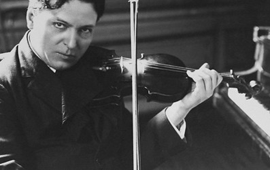> [Archived] Chronicles

Book release at the 'George Enescu' National Museum
'Thank you so much for your kind interest in my Œdipe, I am truly honoured. (...) If everything goes well, hopefully I will finish the score by February, but I also have to take care of the copies and especially of the reduction!'
Those were the words with which, on the 26th of December 1930, George Enescu addressed Jacques Rouché, the director of the Palais Garnier of Paris, who wanted to see Œdipe staged by the institution he was managing at that time. That and other 15 letters were included in the collection George Enescu. Premiera Operei Oedip - pagini de corespondență, coordinated by Georgeta Aneta Băcioiu and released on Tuesday, the 5th of April 2011, at the Music Hall of the Cantacuzino Palace.
The adventure of retracing Enescu's steps
Georgeta Băcioiu found the letters at the National Library of France; that was an extraordinary discovery which deserves to be shared with all the admirers of George Enescu from Romania. The author of the collection offered further information in a statement she agreed to give Radio Romania Music:
'I have had the chance to spend a year in the French culture, under the protective wing of the "George Enescu" Museum, and, while searching for answers about the artistic activity of Enescu at the National Library of France, I came across the letters which Enescu wrote to two of the greatest French music personalities, conductor Philippe Gaubert and the director of the Palais Garnier of Paris, Jacques Rouché.
It has been an extraordinary adventure to transcribe, translate and make necessary annotations to all the 16 letters, most of which talk about the Œdipe subject. Enescu gave precise directions about how he wanted his work to be put on stage, in a very forward but polite manner. There were directions about what types of voices he wanted to play in the performance, about tempos and sonorities, about what he wanted the set to look like, about how he wanted the stage movements to be done. It was delighted to translate and transcribe them. I thoroughly enjoyed the way in which people could once again discover that Enescu was a complex artist, who tried to control the artistic act and not leave anything at random.
Overall, this book proves to be not only a real documentary source, but quite a thrilling read; and it leaves people with the impression that they are in the backstage of the premiere.
Anniversary releases...
This release takes place 75 years from the first performance of Œdipe, according to the director of the "George Enescu" National Museum, musicologist Laura Manolache:
'This year we celebrate 75 years from the Parisian premiere of Œdipe, Enescu's dearest work, as he himself used to say, and the "George Enescu" Museum is planning a few book releases. Then, in May, we will release a piano reduction of Œdipe by Andrei Tănăsescu and we will also organise within the "George Enescu" Festival an exhibition featuring the references for creating and promoting Œdipe by George Enescu.'
… all seasoned with good music
The release was followed by a recital given by pianist Viniciu Moroianu and cellist Lucian Moraru. The audience listened to works belonging to the three most celebrated musicians of the year: Coral and Carillon Nocturne by George Enescu, three moments from the series Années de pélerinage, First Year: Switzerland by Franz Liszt and Concerto for Viola and Orchestra, adapted for viola and piano, by Bela Bartok.
It was a splendid evening in which the release of the letters collection George Enescu wrote to Jacques Rouché and Philippe Gaubert was celebrated through music.
Translated by Raluca Mizdrea and Laura Bosnea
MTTLC, Bucharest University














